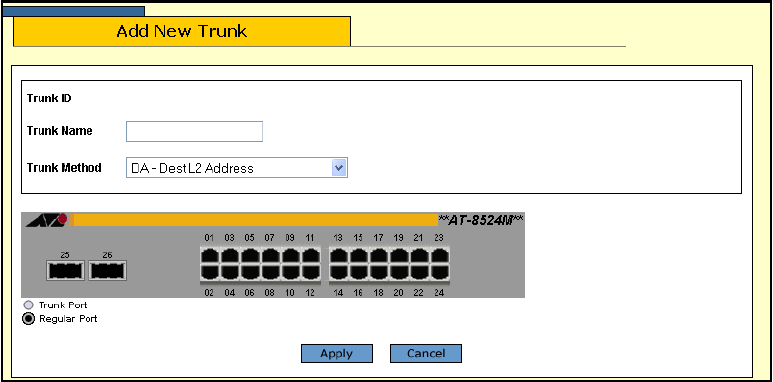User Manual
Table Of Contents
- Contents
- Figures
- Preface
- Section I
- Basic Operations
- Chapter 1
- Starting a Web Browser Management Session
- Chapter 2
- Basic Switch Parameters
- Chapter 3
- Enhanced Stacking
- Chapter 4
- SNMPv1 and SNMPv2c Community Strings
- Chapter 5
- Port Parameters
- Chapter 6
- MAC Address Table
- Chapter 7
- Static Port Trunks
- Chapter 8
- Port Mirroring
- Section II
- Advanced Operations
- Chapter 9
- File System
- Chapter 10
- File Downloads and Uploads
- Chapter 11
- Event Log and Syslog Servers
- Chapter 12
- Classifiers
- Chapter 13
- Access Control Lists
- Chapter 14
- Quality of Service
- Chapter 15
- Class of Service
- Chapter 16
- IGMP Snooping
- Chapter 17
- Denial of Service Defense
- Chapter 18
- Power Over Ethernet
- Section III
- SNMPv3 Operations
- Chapter 19
- SNMPv3
- Enabling the SNMP Protocol
- Configuring the SNMPv3 User Table
- Configuring the SNMPv3 View Table
- Configuring the SNMPv3 Access Table
- Configuring the SNMPv3 SecurityToGroup Table
- Configuring the SNMPv3 Notify Table
- Configuring the SNMPv3 Target Address Table
- Configuring the SNMPv3 Target Parameters Table
- Configuring the SNMPv3 Community Table
- Displaying SNMPv3 Tables
- Section IV
- Spanning Tree Protocols
- Chapter 20
- Spanning Tree, Rapid Spanning Tree, and Multiple Spanning Tree Protocols
- Section V
- Virtual LANs
- Chapter 21
- Port-based and Tagged Virtual LANs
- Chapter 22
- GARP VLAN Registration Protocol
- Chapter 23
- Protected Ports VLANs
- Section VI
- Port Security
- Chapter 24
- MAC Address-based Port Security
- Chapter 25
- 802.1x Port-based Network Access Control
- Section VII
- Management Security
- Chapter 26
- Encryption Keys, PKI, and SSL
- Chapter 27
- Secure Shell Protocol
- Chapter 28
- TACACS+ and RADIUS Authentication Protocols
- Chapter 29
- Management Access Control List
- Index

Chapter 7: Static Port Trunks
96 Section I: Basic Operations
The Add New Trunk page is shown in Figure 22.
Figure 22. Add New Trunk Page
5. In the Trunk Name field, enter a name for the port trunk. The name can
be up to sixteen alphanumeric characters. No spaces or special
characters, such as asterisks and exclamation points, are allowed.
Each trunk must be given a unique name.
6. From the Trunk Method list, select a distribution method. Options are:
SA - Source MAC address (Layer 2)
DA - Destination MAC address (Layer 2)
SA/DA - Source MAC address /destination MAC address (Layer 2)
SI - Source IP address (Layer 3)
DI - Destination IP address (Layer 3)
SI/DI - Source IP address /destination IP address (Layer 3)
7. Click the ports that will make up the port trunk. A selected port
changes to white. An unselected port is black. A port trunk can contain
up to eight ports.
8. Click Apply. The new port trunk is now active on the switch.
9. To permanently save the change, click the Save Config menu option.
10. Configure the ports on the remote switch for port trunking.
11. Connect the cables to the ports of the trunk on the switch.
The port trunk is ready for network operations.










